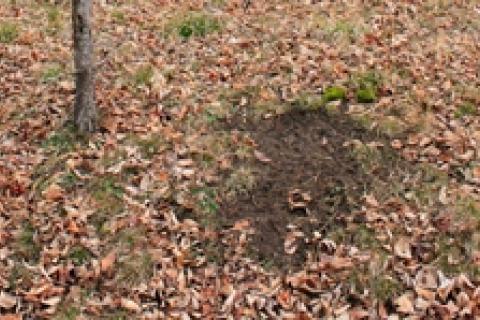
Whether you are a beginner hunter or simply a nature nut, recognizing whitetail deer markings and signs can help you fill your tag or make you a more proficient tracker.
Next time you hit the woods keep your eyes peeled for the following. They will lead you to the deer — and you'll have a better understanding of why they were left in the first place.
| Trails Deer are creatures of habit. They also like to take the road most travelled. The woods and fields are filled with a network of well-worn paths. These safe "highways" are the passages whitetail use to get from their bedding areas to food sources. During winter they can also be a life saver, as fatigue is often beat by walking these trampled paths compared to struggling through the heavy snow. |  |
| Scrapes Rutting bucks mark their territory and announce their presence to other deer by making scrapes. These are created when bucks paw at the ground with their front hooves, leaving a section of fresh earth exposed. They can be as large as 3 square feet. A scent is deposited from a gland located between his toes while digging and he will urinate on the soil once finished. The location for a scrape is almost always under an overhanging branch. This gives the buck the opportunity to disperse his scent once again by nibbling at the tip of the overhanging twig. This is commonly called a "licking branch." A buck will routinely check his scrape sites, and if a receptive doe in heat has visited (and urinated in or near the site) he will then proceed to pursue her. |  |
| Rubs A rub is the exposed section of a tree trunk or branch, which has had the bark removed by the base of a bucks antlers. These are quite easy to spot when out in the woods. While stripping the bark, a buck will deposit scent from the top of his forehead, giving other bucks a warning that this is his territory - and also a signal to does that he is working the area. Rubs excel as both scent and visual cues. |  |
| Bed A bed is the common term used for the spot a deer lays down in. These are used more often during the day and often coincides with chewing of the cud. Beds are much easier to spot after snow has fallen, but can also be distinguished when done in long grass. |  |
| Scat Deer scat can come in two forms — pellet or cluster. Many times this is dictated by what the animal was feeding on. The size of the animal also change the appearance or size of the scat. |  |
| Cloven hooves usually make a split-heart impression and range between 3 and 3.5 inches in length. |  |
| Shed A shed is the term used for an antler that has been cast off naturally after mating season has finished. This is a yearly occurrence. Both antlers are usually cast within a day of each other. Shedding of antlers relieves the buck of the extra weight, ultimately conserving energy for the winter months that lie ahead. Whitetail deer antlers are not used as defensive weapons, but solely as tools for the mating season — both to fight other bucks for prospective mates and to mark territory in hopes of attracting does. |  |
- 4186 views

